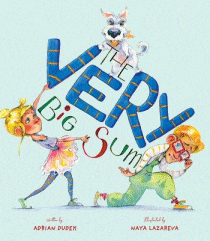
The Very Big Sum
The Very Big Sum
Adrian Dudek
Naya Lazareva
Little Steps, 2023
32pp., pbk., RRP $A16.95
9781922678928
It’s a glorious summer’s day and Teddy and Mabel really want to be outside playing, but instead they are stuck inside helping their mum clean the house. Despite the fact they helped make the mess, like all kids, they are whingeing about having to help when the outdoors beckons.
So their mum agrees that they can go outside WHEN they have found the sum of all the numbers from one to 100. (And, being a smart mum she has removed the batteries from the calculator much to the children’s chagrin.) And so begins a challenge that could be replicated in any family or classroom as the children are challenged to think beyond the obvious way to do things. Can they find the solution before it is too dark to play?
This could be an excellent starting point for getting students to think creatively, particularly in looking for patterns in and between numbers and having them explain their reasoning. How many times did kids come up with something I wasn’t expecting, but their logic was sound? Or flawed so they had to retrace their steps?) For those who like this sort of thing, it could be the springboard for getting them to investigate established patterns like Fibonacci or even inventing their own patterns like next-in-the-sequence for their peers to solve.
Looking for sequences and patterns is not an end in itself though, because it can be a really useful skill when analysing data and findings in research – a critical part of the information literacy process. In fact, the information literacy process can be applied to almost any mathematical problem starting with “What do I know? What do I need to find out? Where can I find that information? … So what began as the familiar grumps of kids being asked to help around the house can actually become something so much more.
